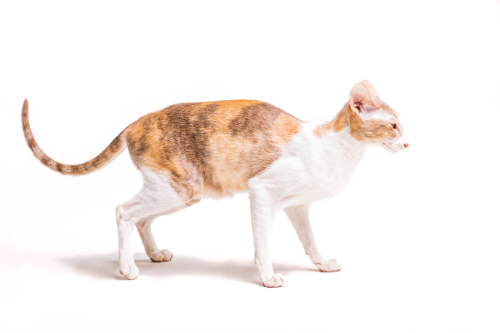How long can a cat go without urinating?
On average, cats don’t pee very often. Many cats pee only once every 12 hours. Some even only once a day. If your cat has not urinated after 24 hours, you should be extra alert to his behavior. After all, it could be that your cat can not urinate.
Cat hasn't peed in two days
In this case it is very worrying. It is therefore wise to take your cat to the vet. He or she can feel his bladder and determine whether your cat may have a urethra blockage in his penis. In this case it mainly concerns tomcats. Female cats are rarely constipated, but in tomcats it is quite common. If your cat can’t pee, it will die if nothing is done about it. And this can happen rather quickly. So there is no time wait and see for a few more days. Even in the evening or on weekends, it is necessary to take your cat to an emergency veterinarian.

Symptoms in a cat that can't pee
Most cats that can’t pee keep trying to do so. So they keep walking to the litter box and straining, but nothing or only a few drops of urine comes out. If a few drops come out, it may look bloody. Or you keep seeing them go outside and then quickly come back inside. In addition, they are usually very restless and do not want to lie down. They meow in a somewhat whining, painful way. Their abdomen can be quite distended. This is especially visible in the somewhat slimmer tomcats. But if your cat is overweight, this is less noticeable.
Your cat may also lick his penis region excessively or attempt to pee in places where he shouldn’t. For example on the couch or on a table.
If your cat has not peed for a while, it may even start to vomit because he becomes nauseous as a result of not being able to get rid of his body waste products through its urine. If your cat can’t pee for much longer, he will become sleepy, lethargic and drowsy, fall into a coma and then die.
Feeling a full distended bladder in your cat
It is possible to feel your cat’s overfull bladder. A normal bladder is possible for a vet to feel, but for you as the owner it is very difficult. If his bladder is overfilled, you can feel a very hard, tense ball in the back of his abdominal cavity. You can feel this under his vertebrae and higher than the abdominal muscles. However, many cats are overweight and then they have a soft sagging belly under their belly. At that point you can not yet feel the abdominal cavity. So then you have to feel more towards his back. Gently feel his entire abdominal cavity to see if you can feel a slightly larger bulb. Your cat may also become very angry if you touch his bladder, so be aware of his nails and teeth.



Your cat can't pee, what to do?
If your cat is trying to pee but can’t, you shouldn’t wait any longer. The longer he can’t pee, the worse he will become and the more difficult it will be for him to survive any anaesthesia. Even if you have the slightest doubt, have your vet check it out. It’s better to go to the vet ten times for nothing than to be late once and end up with a dead cat.
Why can't a cat pee?
There are several possible causes for a cat to be unable to pee. In most cases it is caused by urinary crystals. But swelling of the mucous membrane on the inside of the urethra can also cause a blockage. And stress is a major cause of this. Below we explain the various causes.
Urinary crystals and protein plugs
The most common cause for a cat not being able to pee are urinary crystals. These are small crystals in his urine that are caused by certain salts used in his diet. The more expensive the food is, the better quality the ingredients are. This means there is a less chance of adding less healthy salts in expensive food. If these salts end up in his urine, they can stick together. Then you get crystals in the urine. And if those crystals get even bigger, you get urinary stones. So the cheaper the food you give your cat, the bigger the chance that urinary crystals are the cause of why your cat can’t pee.
But in some cases, cats also make protein deposits in their urine. In that case, proteins that come from the tissues of their kidneys or urinary tract stick together and can block the urethra.
Male cats have a very small, narrow urethra. Small stones or protein accumulations can get stuck in this. And as you can imagine, if a stone is stuck in your urethra, urine will have difficulty seeping through or not at all. The consequence of the blocked urethra is that the bladder fills more and more with urine. However, emptying is no longer possible. His bladder may also rupture after a while, causing urine to drain into his abdominal cavity. Your cat will die due to the inability to remove toxins from his body. So there is every reason to treat a blocked urethra in your cat as quickly as possible.

Swelling of the mucous membranes of the penis
When the mucous membrane on the inside of the penis swells, this swelling can block the urethra. This can occur, for example, as a result of an inflammation, a tumor (in older cats), or as a result of an accident in which the penis has been hit. Stress also appears to be a major cause of swelling of the urethral mucosa and therefor a major cause for cat’s being unable to pee.
Stress
Stress in cats can manifest itself in many different ways. For example, a cat can lick its belly a lot until it’s bald, it can show abnormal behaviour towards you as the owner or towards other animals in its environment. But for some cats (and people!), stress mainly affects their bladder and urinary tract. This can be the cause of inflammation of the mucous membrane in the urethra (and usually the bladder wall itself) which blocks the penis. Your cat can’t pee at that moment.
In most cases, the blockage is first cleared and then medication is given to lower stress. Provided, of course, that your cat had no bladder grit. Zylkène is then the product they prescribe in most cases.
What does a vet do if your cat can't pee?
If it turns out that your cat is indeed have a blocked urethra and therefore can’t pee, your cat will probably be put under anaesthesia. In cats that are in very bad condition, this is sometimes not even necessary. Once a cat is drowsy enough to allow it, your vet will try to insert a very narrow catheter through your cat’s penis. You can compare such a catheter with a very narrow straw. This allows the urine to drain from the bladder.
Your cat will then remain with the catheter in his penis for about two or three days. The vet will probably also start an IV fluid therapy. This way, your cat will consume more fluid so that he produces more urine and your cat’s body and bladder are properly flushed of all the toxins that have accumulated. Your cat will noticeably improve. After 2-3 days, the catheter will be removed and they will monitor whether your cat can pee on its own again. If all goes well, he can go home. If this does not go well, a catheter will be placed again. Or it is immediately decided to surgically remove his penis so that the opening of the urethra becomes larger. That sounds very terrible, but in practice the cats benefit greatly from it. They probably had trouble peeing for some time.
Depending on the cause of the blockage, advice will also be given on how to proceed. This often involves adjusting his diet and examining how stress can be reduced.

How can you prevent your cat from being unable to pee?
Sometimes your cat can just be unlucky and end up with a blocked penis. But in many cases, urinary crystals or stress is the cause. Or being overweight, that is also a thing that is triggering the condition. And you can prevent or reduce these problems.
It is best to give Roycal Canin Calm as food to your cat. This food prevents the formation of bladder grit (that is the S/O index stated on the package) and contains substances that ensure that more serotonin is formed in the brain in a natural way. Because the serotonin level in the brain increases, your cat experiences less stress.
It is also important to prevent your cat from becoming overweight. Being overweight has shown to be more likely to cause a blockage in the penis, causing your cat to no longer be able to pee. Are you unsure whether your cat is too fat? Then ask your vet. In any case, do not put him on a weight-loss diet, but continue to give the above stated food. Give him less food and weigh your cat regularly to see if he is actually losing weight.
You can also try to get your cat to drink more. The more he drinks, the more his urinary tract is flushed and the less chance of proteins, crystals and other substances are accumulating. For example, add some water to his kibble or give him a water fountain. Most cat’s love them!
Good luck!
Hopefully your cat isn’t even unable to pee in the first place. But if he is, we hope he will recover quickly and have a happy life with you. Good luck!



